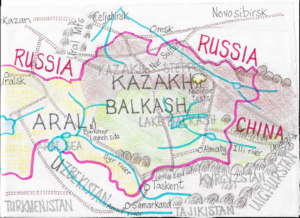Aral

Millisphere: a discrete region inhabited by roughly one thousandth of the world population.
The millisphere of Aral (a bit over four million) covers Kazakhstan’s Syr river watershed draining into the Aral Sea and stretches from the Caspian sea in the west nearly to Tashkent in the south-east. If truly defined on a watershed basis Aral would have to include the dry portion of the Aral Sea, in Uzbekistan, and the lower reaches of the River Amur.
By the end of the 20th Century the Aral Sea achieved worldwide notoriety by drying up completely. A diverse and abundant ecosystem was reduced to a desert in about a century.
It all started with the American Civil War disrupting global cotton production. Seeing an opportunity, Russia went into cotton – building a railway line from Moscow to Tashkent. Water hungry cotton required irrigating and the Syr and Amur rivers were harnessed. Shoddy industrialisation under the Soviets produced leaky canals and reservoirs and by the time the USSR collapsed in 1991 the Aral Sea was dry.
Since 2000 Kazakhstan has built dams to catch what water the Syr still discharges and now the “North” Aral Sea covers about 10% of the Aral’s previous area. Aquatic wildlife was quick to colonise the new lake. It has been estimated that the volume of water coming from a river the size of the Volga would have to run for several years to fill the Aral Sea again. UN funded German water engineers are working with the upstream countries (Uzbekistan, Kyrgyzstan, Tajikistan, Turkmenistan and ultimately Afghanistan) but the Amur remains dry before it reaches the Aral.
Uzbekistan’s response has been to plough up the lake bed in its territory and plant salt tolerant shrubs in an attempt to mitigate the salt storms. Despotic Uzbekistan is also imfamous for its modern day cotton slavery.
My friend Chris, who spent a year teaching in Uralsk, in the north-west, had seen the rusting ships standing in the dry Aral seabed. “It’s tragic what has happened to the Aral, but it is just as sad for the Caspian”.
In the not too distant past the Aral Sea (31m above sea level) would periodically discharge into the Caspian Sea (26m below sea level). Isolated from the oceans for over two million years the Caspian had evolved unique species like the Beluga sturgeon, fished to near extinction for its valuable caviar. The only legal caviar on the world market today is produced in aqua-farms in Florida, USA, and, ironically, fertile eggs from Florida have been released in the Caspian and the Volga river in an attempt to reestablish populations.
“Oil wells flooded and leaking, pesticides, chemicals, heavy metals and untreated sewage spewing out of the Volga from Russia, you wouldn’t want to swim in the Caspian,” Chris said. The Caspian depression contains most of Kazakhstan’s oil and gas.
“And what about Baikonur?” Chris added when we discussed the environmental problems of Aral. Once on a three day taxi ride from Uralsk to Almaty Chris had passed near the Baikonur space launch site – the most costly project ever undertaken by the USSR. Yuri Gagarin, the first human in space, was launched from Baikonur.
After the Soviet Union collapsed Russia leased Baikonur from Kazakhstan and, allied with the United States, got paid to send American astronauts to the international space station – to which China is excluded. Baikonur has a rough and dirty history, dangerously discharging launch debris and causing health problems for nearby residents. Today scrap metal recovery is a local economic activity and there have been no launches since 2019 because of lack of funds.
Uralsk, where Chris taught, is right on the border with Russia and most people spoke Russian there (20% of the Kazakhstan population is Russian). Chris had planned to do one more stint in Kazakhstan but covid intervened. As of August 2021 Kazakhstan (population 19 million) is reporting 10,000 new Covid cases per day and has had over 11,000 covid deaths. Just across the border in China (population 1,440 million) they are reporting 50 odd covid cases per day and their total covid deaths stands at 4,600. What a difference a border can make.
